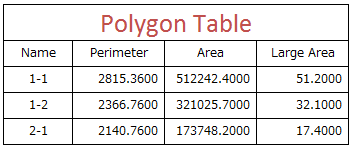Create Polygon Label Tables
Create and display in the Plan View and Sheet View a table from selected polygons, rectangles, and circles that automatically enumerates their attributes (for example, perimeter and area) based on the selected label table style.

Note: To ensure that the size of dimensions or labels is correct when viewed in the Plan View, verify that the plot scale for the project is set correctly in Project Settings > View > Plan View. The plot scale is the factor used to convert from ground units to sheet units (ground units / plot scale = sheet units). For example, if the default plot scale of 600 is used, an object with a length of 600 m in the Plan View will plot with a length of 1 m on paper. In survey feet, the default plot scale of 50 will plot as 1 foot on paper.
Prerequisites:
- Licensed module. See the Subscription Plans page. For a license matrix by command, see the License page in the TBC Community. Also see View and manage licensed features.
- label table style
To create polygon label tables:
- Select Create Polygon Label Table in Drafting > Tables to display the Create Polygon Label Table command pane.
- In the Title field, enter a title for the new label table.
- Optionally, select a different Layer on which to display the new label table
- In the Style drop-down list, select the style you want to apply to the new label table, or select <<New Style>> to create a new style using the Label Table Style Manager.
The label table style you select specifies the type of information to be displayed in each column in the table (for example, the perimeter and area of the polygon), the display of text in the table (including precision formatting, the use of unit suffices, and text justification) and the appearance of the table itself (including text styles and table borders).
- Click in the Location field and then click in the Plan View where you want the upper left corner of the new label table to be located (or enter a coordinate).
The label table displays in the Plan View. It includes the table title you specified and the column headings and borders specified by the selected style. In addition, the Edit Label Table pane displays.
When you create a polygon label table, each object included in the table is labeled in the graphic view either with its name or, if it has not been named, an auto-generated name you can specify in the next step. The label in the object provides a cross-reference to the name in the table. You can also select the polygon style for the label that will determine its content and format.
- In the Edit Label Table pane, use the Polygon label style drop-down list to select the style you want to apply to the object labels when the label table is created. Or, select <<New>> to create a new label style.
- If you are including objects in the table that do not have names, optionally make changes in the Generate a new polygon name fields.
- In the Name format field, edit the polygon name format (for example, enter "Polygon#" to include the word "Polygon" followed by a sequential number).
- In the Start number field, enter the first number to use in sequential numbering in the table.
- Click in the Target polygon selection field and then click in the Plan View to select one or more polygons, rectangles, or circles you want to include in the table (use Ctrl + click or draw a selection box to make your selection). If necessary, click the Option button for additional selection options.
- Click the Add button to add the selected objects to the label table.
In the graphic view, the label table is updated to show the selected objects.
Optionally, use the Remove button to remove any objects from the table list.
Note the following when working with label tables:
- Each row in the table is updated automatically when any of the displayed attributes for the associated object changes (for example, a object is moved). If an object is deleted, the associated row is removed from the label table.
- The Explode command will break a label table into lines and text.
- When exporting project data to a DXF or DWG file, label tables are converted into CAD block objects, resulting in the loss of the association between tables and target objects.
- When importing label tables from DXF or DWG files, the tables are converted into CAD block objects, resulting in the loss of the association between tables and target objects.